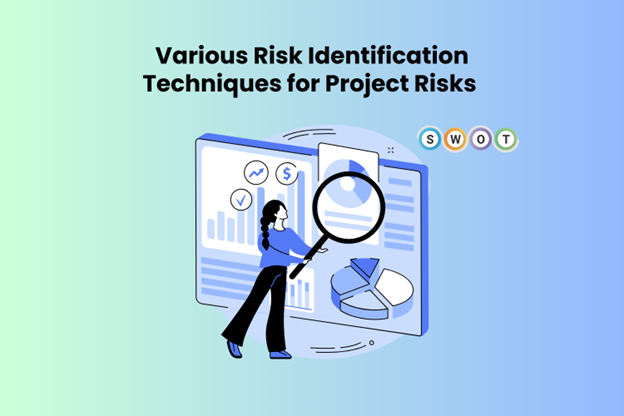Various Risk Identification Techniques for Project Risks

In the world of project management, where uncertainty lurks at every corner, adept risk identification is the cornerstone of successful project execution. Whether you’re a seasoned project manager or someone embarking on a Project Management Training Course, understanding and mastering risk identification techniques is essential.
Effectively managing project risks is not only about foreseeing potential hurdles but also about devising strategies to mitigate or capitalise on them. In this exploration of various risk identification techniques, we delve into the realm of Managing Project Risks and Uncertainty.
Table of Contents
- Brainstorming Sessions
- SWOT Analysis
- Risk Registers
- Delphi Technique
- Cause and Effect Diagrams (Fishbone Diagrams)
- Scenario Analysis
- Checklists
- Conclusion
Brainstorming Sessions
One of the most common yet effective techniques for identifying project risks is through brainstorming sessions. This involves gathering key stakeholders, team members, and subject matter experts to generate a comprehensive list of potential risks.
By encouraging open dialogue and leveraging diverse perspectives, brainstorming sessions can uncover risks that might have otherwise gone unnoticed. This technique fosters collaboration and enhances buy-in from team members, ultimately enriching the risk management process.
SWOT Analysis
SWOT (Strengths, Weaknesses, Opportunities, Threats) analysis is another valuable tool for identifying project risks. By evaluating internal strengths and weaknesses, external opportunities and threats, project managers can gain a holistic view of potential risks.
This technique not only helps in identifying risks but also aids in understanding the project’s strategic position within its environment. Integrating SWOT analysis into risk identification enables project teams to proactively address vulnerabilities and capitalize on opportunities.
Risk Registers
Utilizing risk registers is a systematic approach to identifying and documenting project risks. A risk register is a repository that captures essential details about identified risks, including their likelihood, impact, and potential response strategies.
By maintaining a centralized risk register, project managers can continuously monitor and update the status of risks throughout the project lifecycle. This technique promotes transparency and accountability, ensuring that risks are effectively managed and mitigated.
Delphi Technique
The Delphi Technique is a structured method for gathering input from experts to reach a consensus on potential risks. In this technique, experts anonymously provide their opinions on various project risks, which are then aggregated and iteratively refined through multiple rounds of feedback.
By harnessing the collective wisdom of experts, the Delphi Technique facilitates the identification of both common and obscure risks. This approach is particularly useful for complex projects or those operating in rapidly evolving environments.
Cause and Effect Diagrams (Fishbone Diagrams)
Cause and Effect Diagrams, also known as Fishbone Diagrams, are visual tools used to explore the root causes of potential risks. By categorizing causes into broad categories such as people, process, technology, and external factors, project teams can uncover underlying issues that may lead to risks.
This technique encourages structured brainstorming and helps in identifying both direct and indirect contributors to project risks. Cause and Effect Diagrams provide a comprehensive framework for understanding the interconnectedness of risk factors.
Scenario Analysis
Scenario analysis involves developing hypothetical scenarios to assess the potential impact of various risk events on project objectives. By creating multiple plausible scenarios based on different combinations of risk factors, project teams can anticipate potential outcomes and devise contingency plans accordingly.
This technique enables proactive risk management by simulating different future states and evaluating their implications. Scenario analysis fosters resilience and flexibility in project planning, allowing teams to adapt to changing circumstances effectively.
Checklists
Checklists are simple yet powerful tools for systematically identifying project risks. By referencing predefined lists of common risk categories or indicators, project managers can ensure that no critical risks are overlooked.
Checklists serve as handy reminders and facilitate a structured approach to risk identification, especially for less experienced project teams. While not exhaustive, checklists provide a baseline for risk assessment and can be tailored to suit the specific needs of each project.
Conclusion
Managing project risks and uncertainty is a multifaceted endeavor that requires proactive identification and mitigation strategies. By employing various risk identification techniques such as brainstorming sessions, SWOT analysis, risk registers, the Delphi Technique, Cause and Effect Diagrams, scenario analysis, and checklists, project managers can effectively anticipate, assess, and address potential risks.
Whether you’re undergoing project management training or leading complex projects, mastering these techniques is essential for ensuring project success in an increasingly uncertain world. By embracing risk as an inherent aspect of project management and leveraging appropriate tools and methodologies, organizations can navigate challenges with confidence and achieve their objectives.




